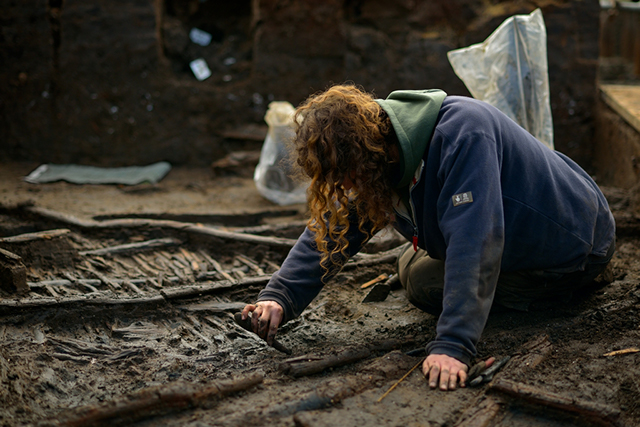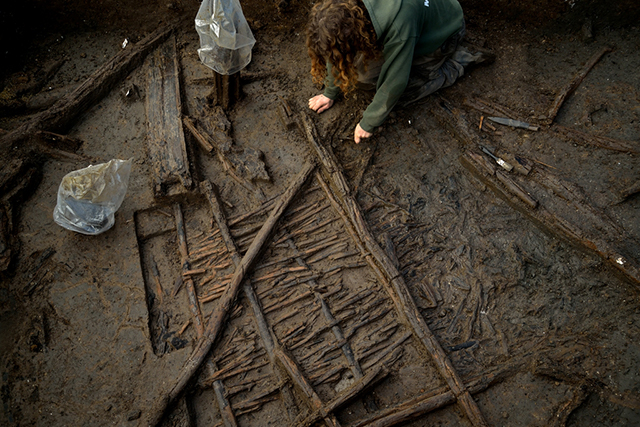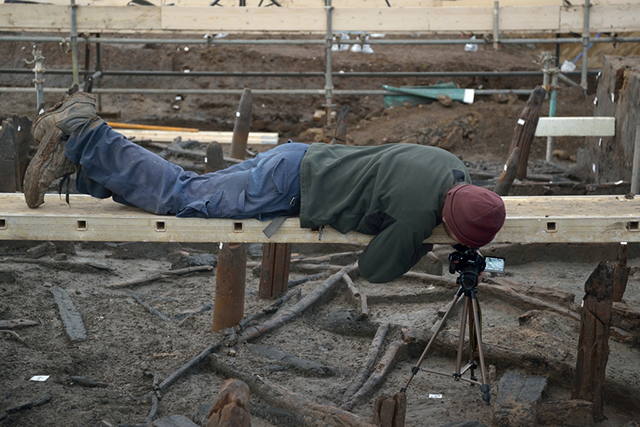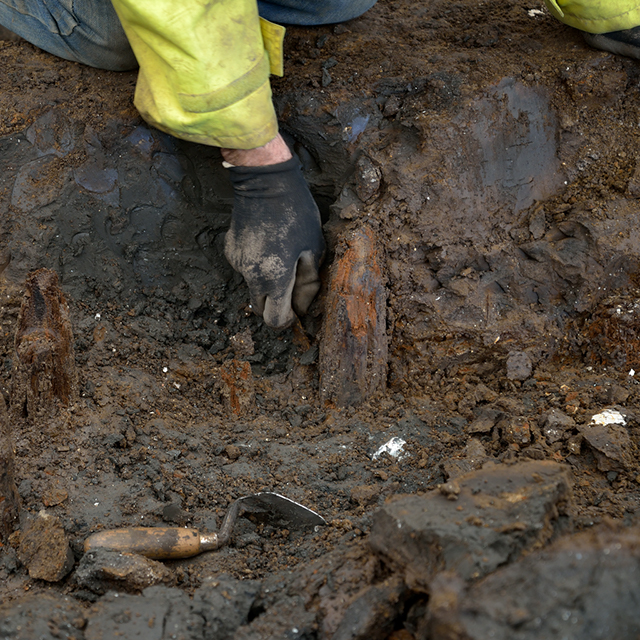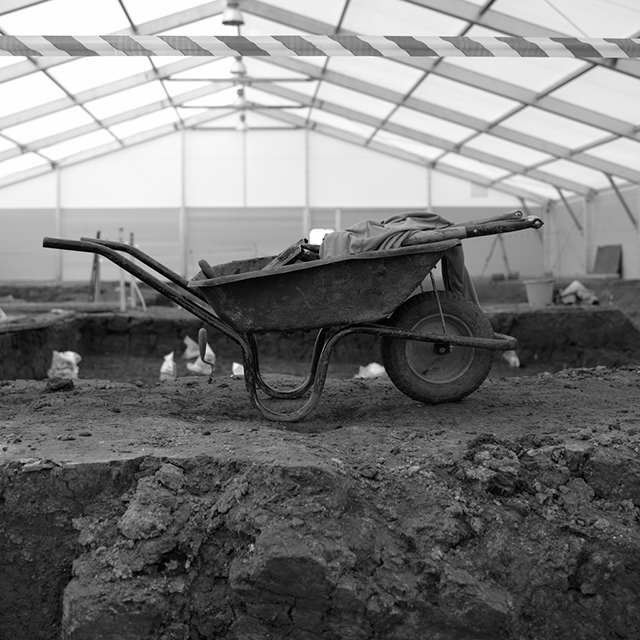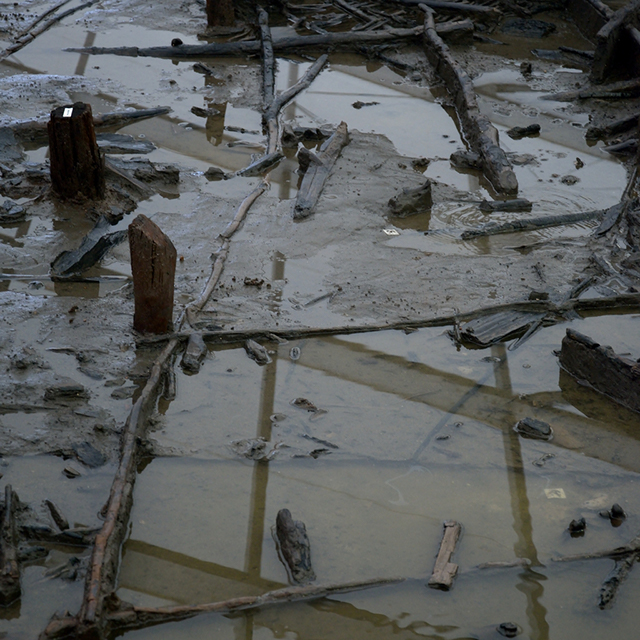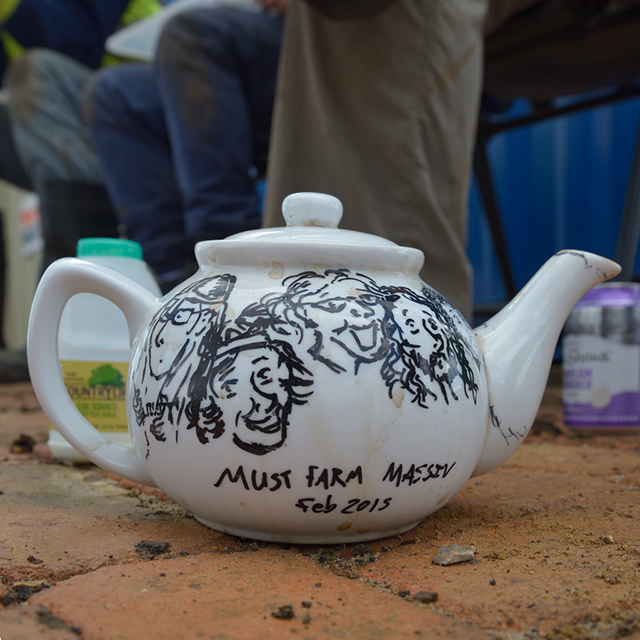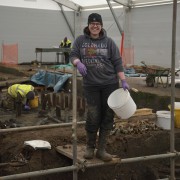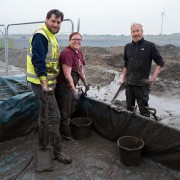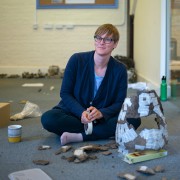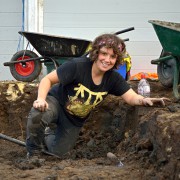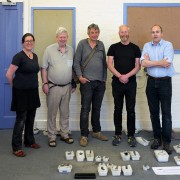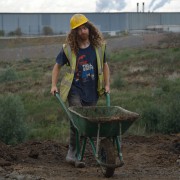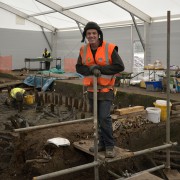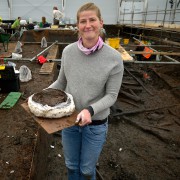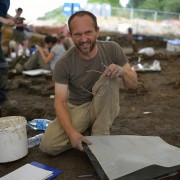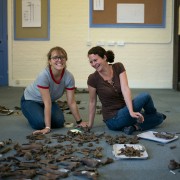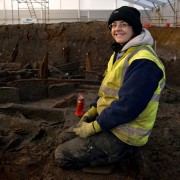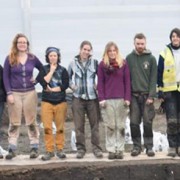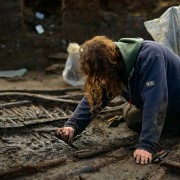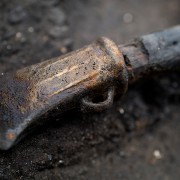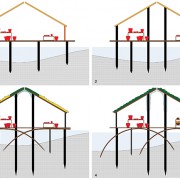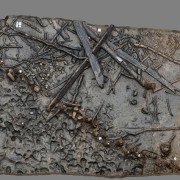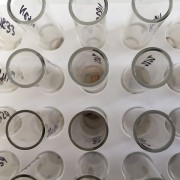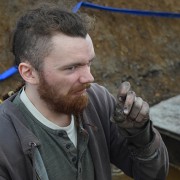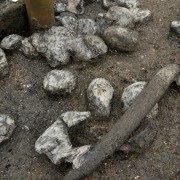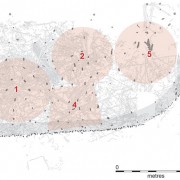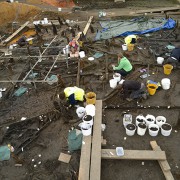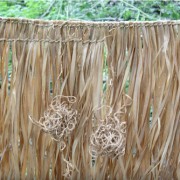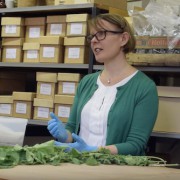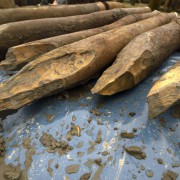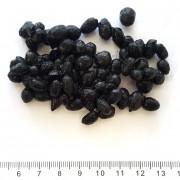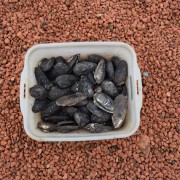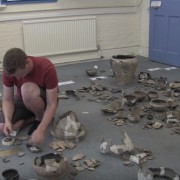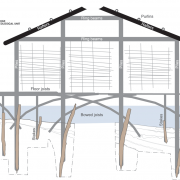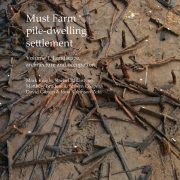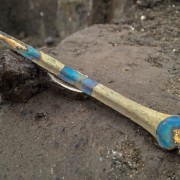Post Ex-Diary 21: The Importance of Visualisation – Photography Part Two
February 17, 2020
Following on from our last blog post, The Importance of Visualisation – Photography Part One, we continue to explore the value of archaeological photography to the Must Farm project. In this post we are focusing on the role of working shots, site record shots and highlighting the importance of people in photographs.
Working Shots
Working shots are photographs that depict the wider process of an archaeological excavation beyond the material record. They are generally considered less formal and typically feature the archaeological methods and techniques being used to deal with features and artefacts. These can be used to illustrate discussions on why certain approaches were taken, to provide an archive of the stages a project goes through or to quickly record archaeology when more formal photographs would not be possible or appropriate.
Often working shots are the best method for recording the ongoing work on a project. At Must Farm, these proved invaluable as we were constantly uncovering new artefacts and materials and working photographs were perfect for recording these moments.
A lot of the material at the Must Farm pile-dwelling was very delicate and required slow, methodical and very careful techniques to reveal and clean. Just outside one of our structures, Roundhouse One, we encountered a remarkably well-preserved section of wattle. While the wood was in excellent condition, it was fragile and required the team to use a series of wooden tools to gently remove the surrounding sediments without scratching or marking the wattle. This working shot shows that process in progress, recording the techniques in use and how each piece of wood, even the smallest fragments at the edges, had to be meticulously cleaned.
When documenting a project’s methods and techniques using working shots, it is important to take multiple photographs to provide an overview of the archaeology and the processes being used. This image records the wattle panel being cleaned from above, showing its extent and the painstaking process of removing the sediments.
Working shots are not only used to capture the physical excavation methods and areas of archaeology but also the techniques used to record them. This photograph highlights the lengths we needed to go to in order to create some of our 3D models of the site. Once a section of archaeology had been completed and a single context, or layer, had been exposed and cleaned we used digital cameras to record it. These images were then used to create 3D models which helped us to create scale plans and guide our excavation strategies. However, it was necessary to create scaffold frames and use boards to reach every nook and cranny.
Site Record Shots
Documenting the progress of an excavation and its significant moments is another key component of archaeological photography. However, they also include capturing the day-to-day activities that keep the excavation moving forwards. These images are important in the history of the project and reflect the milestones and small details that are often missing from many depictions of an excavation.
Many of these photographs reflect the events and “little things” on an excavation that are important to us. They could be images showing our first glimpses into new features or areas of archaeology, photos that capture the challenges of using a certain method of excavating or even pictures of the team trying to warm up in the site hut on a dark and freezing winter morning. Site record shots help to flesh out the story of an excavation and depict both the everyday occurrences and the key achievements of a project.
This record shot shows the first appearance of the tops of Bronze Age posts as we started to carefully remove sediments. This was a painstaking process to avoid damage to the archaeology and required a slow and steady technique. The wood around the tops of the posts was very soft, as it was at the boundary of the water table, and was not as well preserved as the lower sections of timber. Seeing these 3,000-year-old emerge was fantastic and it felt like the project had really begun.
During the excavation we separated the site into distinct areas separated by baulks. Baulks are effectively unexcavated areas that can be used to view the layers of archaeology in their sections. They are also useful walkways for moving around the site and create wheelbarrow runs to allow spoil to be removed easily. This black and white site record shot shows one of our barrows first thing in the morning before starting work on cleaning the face of an old section from a previous excavation. In the background, one of the areas of the site has just started to reveal the tips of posts which were given plastic bag “hats” to help keep them damp. This photograph reflects one of the last stages of removing large quantities of sediment and the shift to more delicate excavation techniques.
This site record shot illustrates some of the challenging conditions we faced during the excavation. Despite having a roof over our heads that kept the worst of the weather out there were times when areas of the site flooded. Keeping the site and its mass of wood damp was vital to help avoid any decay but this amount of water made work recording timbers and removing sediments difficult. Photographs that show not only the condition of the archaeology, but the weather and environment too are important in documenting their potential effects and their impact on the project.
Site record shots document more than simply the work on site and this photograph is of one of the teapots we used during the excavation. Archaeology is a tough job. It can be muddy, cold, physical, challenging and requires a lot of thought and discussion behind what can appear to be the simplest decisions. Having a close bond with your colleagues is vital and the simplest of pleasures, like a nice hot cup of tea on a freezing, damp day, are essential for keeping spirits up. We decided to decorate this teapot with portraits of the team and this image helps to make it feel like an archaeological artefact.
People
Archaeology is fascinated with uncovering and exploring the lives of people from the past. Yet, for a subject so focused on people, they are often absent from archaeological photographs. When people do appear in an image, they are typically used as a scale or hunched over with their face hidden by a hardhat.
It is the people of archaeology, the diggers, specialists and contractors, that make the project work. They manage the logistics, excavate the archaeology, study the material and make sense of the data. However, these “people of archaeology” rarely feature in the work they do. One of the most undervalued elements of archaeological photography is images that capture these people.
At Must Farm we were fortunate enough to work with hundreds of individuals from a wide range of backgrounds. From people working in aggregates and scaffolding to scientists and journalists, all have contributed to the completion of the excavation and the ongoing research into the material from the Must Farm pile-dwelling.
While we can only share a few photos, this small selection shows some of the faces involved with Must Farm and hopefully puts some people back into the archaeological record.
We’d like to thank Dave Webb for his fantastic images for these blogs. You can follow him on Twitter @PhotoWebb and see more of his work on his website http://archdiggers.co.uk/
Related stories
Post Ex-Diary 22: Working Towards Publication
May 11, 2020
Post Ex-Diary 21: The Importance of Visualisation – Photography Part Two
February 17, 2020
Post-Ex Diary 19: The Importance of Visualisation – Illustration
December 9, 2019
Post-Ex Diary 18: The Importance of Visualisation – Photogrammetry
November 11, 2019
Post-Ex Diary 17: Stable Isotope Analyses and Must Farm
October 7, 2019
Post Ex-Diary 16: Parasites and Lifestyles at Must Farm
September 3, 2019
Post Ex-Diary 15: Exploring Structure 4 Part Two
August 5, 2019
Post Ex-Diary 14: Exploring Structure 4 Part One
July 15, 2019
Post-Ex Diary 13: The Must Farm Pile-Dwelling Settlement Open Access Antiquity Article
June 12, 2019
Post-Ex Diary 11: The Must Farm Textiles Part One
April 1, 2019
Post-Ex Diary 10: Specialist Analyses Part Three
March 4, 2019
Post-Ex Diary 9: Specialist Analyses Part Two
February 4, 2019
Post-Ex Diary 8: Specialist Analyses Part One
January 7, 2019
Post-Ex Diary 7: The Must Farm Pottery Refit
November 5, 2018
Learn more
About
The Must Farm pile-dwelling settlement was excavated by the Cambridge Archaeological Unit with funding from Historic England and Forterra.Publications
Read the Open Access publications the Must Farm pile-dwelling settlement: Volume 1. Landscape, architecture and occupation and Volume 2. Specialist reports.Dig Diaries
The excavation of the Must Farm settlement was carried out between August 2015 and August 2016. Take a look at our diary entries documenting the excavation process. ...read more
Discoveries
See some of the discoveries from the Must Farm pile-dwelling settlement.
Making Must Farm
Find out about our work with AncientCraft recreating Must Farm’s material.
FAQs
Further information on the Must Farm project.

